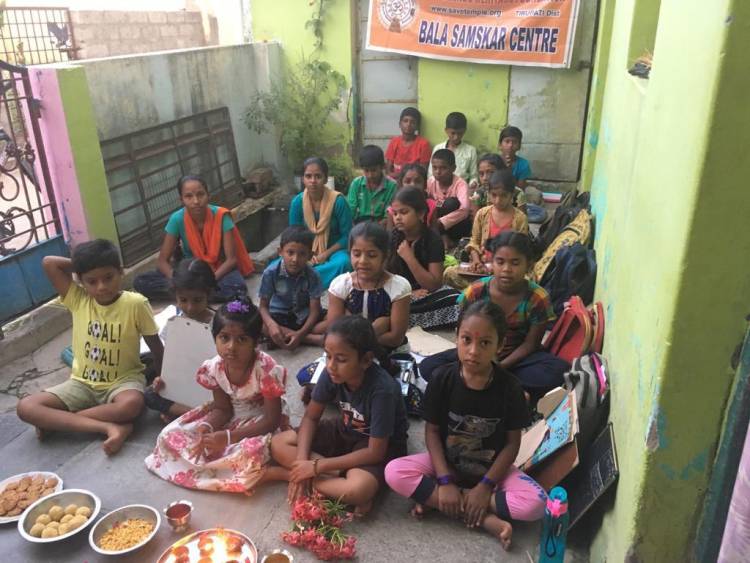[GHHF] Bala Samskar Kendras celebrated Diwali in all Six States
 Professor Spirkin writes: " The sages of India discovered astonishingly subtle and profound psycho-biophysical connections between human organism and cosmic subterranean processes. They knew much that even today is beyond the ken European scientific thought, or that it ignores, often trying to conceal its helplessness by asserting that oriental wisdom is mere mysticism, and thus showing its inability to distinguish the rational but not yet fully understandable essence from various figments of imagination… “
Professor Spirkin writes: " The sages of India discovered astonishingly subtle and profound psycho-biophysical connections between human organism and cosmic subterranean processes. They knew much that even today is beyond the ken European scientific thought, or that it ignores, often trying to conceal its helplessness by asserting that oriental wisdom is mere mysticism, and thus showing its inability to distinguish the rational but not yet fully understandable essence from various figments of imagination… “
Diwali is the most important festival of lights for Hindus and other faiths across India and its diaspora12. It celebrates the triumph of light over darkness, knowledge over ignorance, and good over evil. It is also a time for prayer, feasts, fireworks, family gatherings, and charitable giving15. For some, it marks the beginning of a new year1. One of the popular stories behind Diwali is the return of Lord Rama to Ayodhya after defeating Ravana. Diwali falls on the day of 'Amavasyaa', when there is no moon3. The light symbolizes hope, positive energy, purity, wealth, power, health and good luck34. Diwali is an occasion to unite and spread harmony and prosperity.
Facts about Diwali
1) Diwali is an important religious festival originating in India. People often think of Diwali as a Hindu festival, but it is also celebrated by Sikhs and Jains.*
2) Diwali takes place annually and lasts for five days, marking the start of the Hindu New Year. The exact dates change each year and are determined by the position of the moon – but it usually falls between October and November.
3) The word Diwali (or Deepavali as it’s sometimes called) means “row of lights” in an Ancient language of India, called Sanskrit. During this festival, people decorate their homes with lights and oil lamps, called diyas.
4) For many people, Diwali honours the Hindu goddess of wealth, Lakshmi. The lights and lamps are said to help Lakshmi find her way into peoples’ homes, bringing prosperity in the year to come!
5) It’s also a celebration of good triumphing over evil, and different legends based on this theme are associated with Diwali. In northern India, Hindus celebrate the return of the deities (gods) Rama and Sita to the city of Ayodhya, after defeating the evil king Ravana!
6) In the region of Bengal people worship the goddess Kali, the destroyer of evil forces, during Diwali. And in Nepal (a country bordering north-east India), people celebrate Lord Krishna’s victory over the wicked king Narakaasura.
7) But it’s not just about lights and legends –– Diwali is a time to have fun with friends and family! People exchange gifts and sweets, enjoy delicious feasts, watch firework displays and wear new clothes. It’s a time to clean and decorate your home, too.
8) Rangoli is a popular Diwali tradition –– beautiful patterns made using colourful powders and flowers. People draw rangoli on the floor by the entrance of their homes to welcome the gods and bring good luck!
9) Today, this fascinating festival is celebrated by thousands of people in countries all around the world. During Diwali, Hindus living outside India gather at places of worship called mandirs to leave offerings to deities, watch firework displays and eat yummy food together!
10) The city of Leicester, in the United Kingdom, holds the largest Diwali celebrations outside of India. Every year, tens of thousands of people gather in the streets to enjoy vibrant shows of light, music and dancing!(Source – National Geographic)
DONATIONS
1) Sponsor one Bala Samskar Kendra for $1000.00 per year
2) Sponsor one Pracharak: it would cost approximately $3000.00 per year.
3) Sponsor a Priest: $1500 per year
Payment Methods:
PayPal Method: Savetemples.org
By Zelle: ghhfusaorg@gmail.com
By Check: Or you can send a check payable to GHHF, It is tax-deductible.
RUPEES, if you would like to contribute to rupees, please either call or send an email. Phone: 601-918-7111; For more information, call Prakasarao Velagapudi at: Email: ghhfusaorg@gmail.com



















 Urgent support needed for Bangladesh Hindus
Urgent support needed for Bangladesh Hindus 







